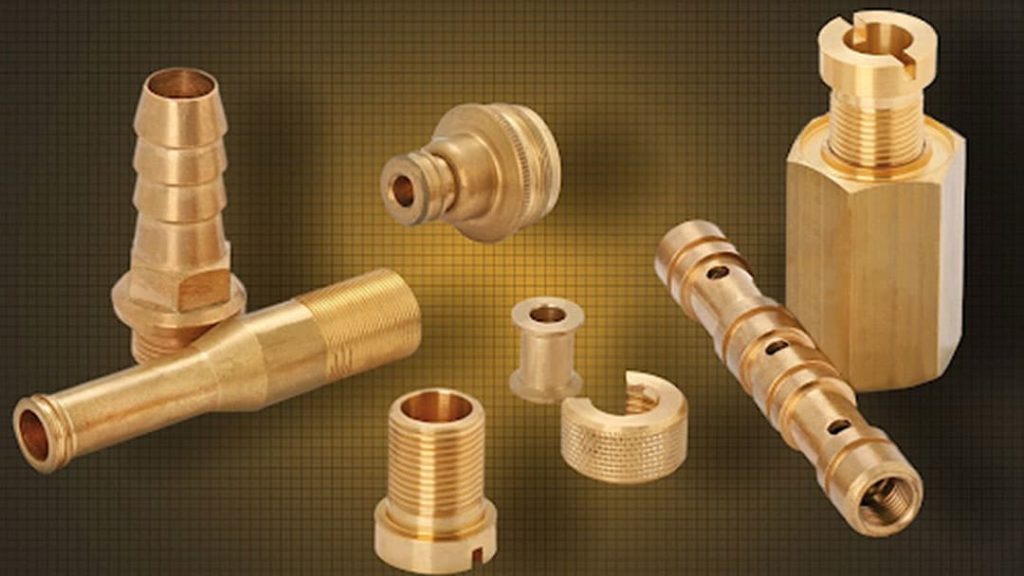What is copper alloy 260 brass? 260 Brass, often called cartridge brass, is a metal that’s resistant to corrosion in most environments. It’s a copper-zinc alloy that has a shiny, yellow appearance.
Many builders and manufacturers refer to 260 brass as the workhorse of all varieties of copper alloys. 260 Brass can also be used with materials like ammonia compounds and acetic, nitric, and hydrochloric acid.
260 Brass is a material well-suited for a wide range of applications, from home furnishing and artwork to musical instruments and complex electronic components.
260 Brass Properties
260 Brass is made up of 68.5-71.5% copper and 28.5-31.5% zinc. It can also contain up to 0.07% lead and 0.05% iron. Let’s take a look at the material’s characteristics:
- Hardness: B77—Rockwell scale
- Yield strength: 52,000 PSI
- Maximum tensile strength: 62,000 PSI
- Electrical conductivity rating: 28%—International Annealed Copper Standard
- Elongation: 53%
- Electrical resistivity: 0 ohms
- Modulus of elasticity: 16,000,000 PSI
- Density: 308 lb/in3 @ 68° F
- Thermal conductivity: 70 BTU-ft/ft2-hr-°F
- Coefficient of thermal expansion: 1 PPM/°F—68-572°F
These properties of 260 brass influence how it’s used in industrial applications and manufacturing processes.
- Because it’s resistant to corrosion, 260 brass is well-suited for applications that involve regular exposure to the elements.
- Because its ductility is the highest of all yellow brass—it doesn’t lose structural integrity—manufacturers use 260 brass in a wide range of applications.
- It has high workability, meaning it’s ideal for many fabrication processes like cutting, bending, forming, and machining. It’s not recommended to weld 260 brass, but in certain conditions, you can solder or braze it. It’s important to note that, in the material’s half-hard state, 260 brass has a machining rating of 30, which means it’s poorly suited for machining operations.
260 Brass Applications
Next, let’s look at some common applications for 260 brass:

- Ammunition
- Appliances
- Electronic and electrical equipment
- Engraved plates
- Fasteners
- Furniture
- Hinges
- Instruments
- Lamps
- Locks
- Plugs
- Radiator tanks and cores
- Valve components
What Is the Difference Between 260 and 360 Brass?
There are a few differences between 260 and 360 brass. 360 Brass, also called leaded brass, is made up of 61.5% copper and 35.5% zinc, 3% lead, and 0.35% iron.
Related: Ferrous vs. Non-Ferrous Metals
The characteristics of 360 brass include:
- Hardness: B78—Rockwell scale
- Yield strength: 45,000 PSI
- Maximum tensile strength: 58,000 PSI
- Elongation: 25%
- Density: 0.307 lb/in3
It also has corrosion-resistant properties like 260 brass. 360 Brass has a higher machinability rating than any other copper alloy, meaning it can easily accommodate many machining operations.
360 brass applications include:
- Central heating system parts—Adapters, fittings, and valves
- Electrical equipment parts—Contacts and hardware
- Musical instruments—Horns, trombones, and trumpets
- Plumbing system components—Adapters, fittings, shafts, and valve stems
- Screw machine parts—bolts, connectors, couplings, and nuts.
Looking for the best metals to get your next project done right? Get in touch with South Austin Metals—Your trusted South Austin fabricator, welder, and supplier for over 50 years!
Related: Types of Metal and Their Uses

